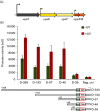A conserved hexanucleotide motif is important in UV-inducible promoters in Sulfolobus acidocaldarius
- PMID: 28463103
- PMCID: PMC5817253
- DOI: 10.1099/mic.0.000455
A conserved hexanucleotide motif is important in UV-inducible promoters in Sulfolobus acidocaldarius
Abstract
Upon DNA damage, Sulfolobales exhibit a global gene regulatory response resulting in the expression of DNA transfer and repair proteins and the repression of the cell division machinery. Because the archaeal DNA damage response is still poorly understood, we investigated the promoters of the highly induced ups operon. Ups pili are involved in cellular aggregation and DNA exchange between cells. With LacS reporter gene assays we identified a conserved, non-palindromic hexanucleotide motif upstream of the ups core promoter elements to be essential for promoter activity. Substitution of this cis regulatory motif in the ups promoters resulted in abolishment of cellular aggregation and reduced DNA transfer. By screening the Sulfolobus acidocaldarius genome we identified a total of 214 genes harbouring the hexanucleotide motif in their respective promoter regions. Many of these genes were previously found to be regulated upon UV light treatment. Given the fact that the identified motif is conserved among S. acidocaldarius and Sulfolobus tokodaii promoters, we speculate that a common regulatory mechanism is present in these two species in response to DNA-damaging conditions.
Conflict of interest statement
The authors declare that there are no conflicts of interest.
Figures





Similar articles
-
Species-Specific Recognition of Sulfolobales Mediated by UV-Inducible Pili and S-Layer Glycosylation Patterns.mBio. 2020 Mar 10;11(2):e03014-19. doi: 10.1128/mBio.03014-19. mBio. 2020. PMID: 32156822 Free PMC article.
-
Effect of UV irradiation on Sulfolobus acidocaldarius and involvement of the general transcription factor TFB3 in the early UV response.Nucleic Acids Res. 2018 Aug 21;46(14):7179-7192. doi: 10.1093/nar/gky527. Nucleic Acids Res. 2018. PMID: 29982548 Free PMC article.
-
Responses of hyperthermophilic crenarchaea to UV irradiation.Genome Biol. 2007;8(10):R220. doi: 10.1186/gb-2007-8-10-r220. Genome Biol. 2007. PMID: 17931420 Free PMC article.
-
Repair of UV damage in Halobacterium salinarum.Biochem Soc Trans. 2003 Jun;31(Pt 3):694-8. doi: 10.1042/bst0310694. Biochem Soc Trans. 2003. PMID: 12773185 Review.
-
Homologous recombination in Sulfolobus acidocaldarius: genetic assays and functional properties.Biochem Soc Trans. 2009 Feb;37(Pt 1):88-91. doi: 10.1042/BST0370088. Biochem Soc Trans. 2009. PMID: 19143608 Review.
Cited by
-
Participation of UV-regulated Genes in the Response to Helix-distorting DNA Damage in the Thermoacidophilic Crenarchaeon Sulfolobus acidocaldarius.Microbes Environ. 2019 Dec 27;34(4):363-373. doi: 10.1264/jsme2.ME19055. Epub 2019 Sep 21. Microbes Environ. 2019. PMID: 31548441 Free PMC article.
-
Sulfolobus acidocaldarius Transports Pentoses via a Carbohydrate Uptake Transporter 2 (CUT2)-Type ABC Transporter and Metabolizes Them through the Aldolase-Independent Weimberg Pathway.Appl Environ Microbiol. 2018 Jan 17;84(3):e01273-17. doi: 10.1128/AEM.01273-17. Print 2018 Feb 1. Appl Environ Microbiol. 2018. PMID: 29150511 Free PMC article.
-
A CRISPR-associated factor Csa3a regulates DNA damage repair in Crenarchaeon Sulfolobus islandicus.Nucleic Acids Res. 2020 Sep 25;48(17):9681-9693. doi: 10.1093/nar/gkaa694. Nucleic Acids Res. 2020. PMID: 32833023 Free PMC article.
-
Characterization of promoters in archaeal genomes based on DNA structural parameters.Microbiologyopen. 2021 Oct;10(5):e1230. doi: 10.1002/mbo3.1230. Microbiologyopen. 2021. PMID: 34713600 Free PMC article.
-
Phosphoproteomic Analysis Reveals Rio1-Related Protein Phosphorylation Changes in Response to UV Irradiation in Sulfolobus islandicus REY15A.Front Microbiol. 2020 Dec 3;11:586025. doi: 10.3389/fmicb.2020.586025. eCollection 2020. Front Microbiol. 2020. PMID: 33343525 Free PMC article.
References
-
- Karr EA. Advances in Applied Microbiology. 1st ed. vol. 89. Elsevier Inc; 2014. Transcription regulation in the third domain; pp. 101–133. - PubMed
Publication types
MeSH terms
Substances
LinkOut - more resources
Full Text Sources
Other Literature Sources
Miscellaneous

